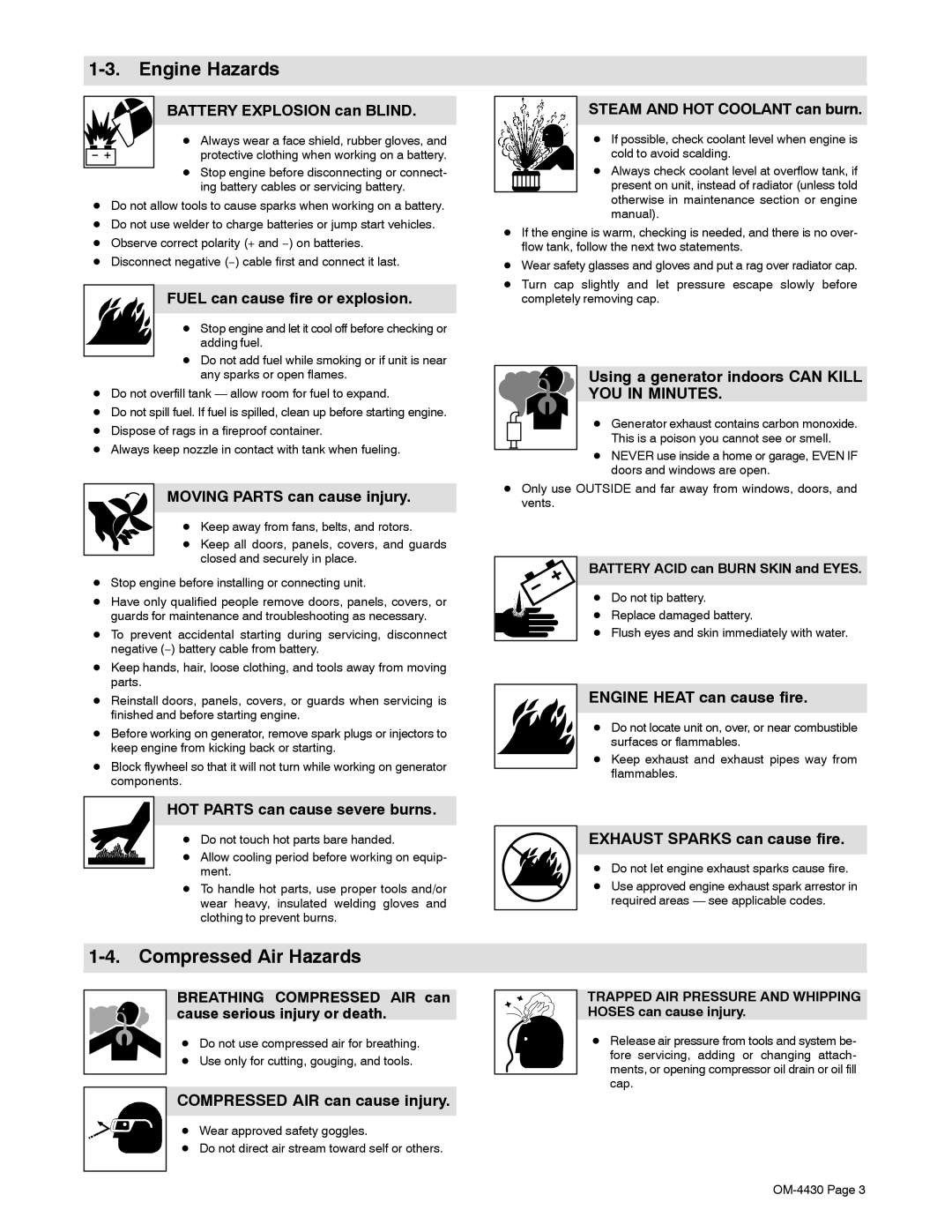
1-3. Engine Hazards
BATTERY EXPLOSION can BLIND.
DAlways wear a face shield, rubber gloves, and
protective clothing when working on a battery.
D Stop engine before disconnecting or connect- ing battery cables or servicing battery.
DDo not allow tools to cause sparks when working on a battery.
DDo not use welder to charge batteries or jump start vehicles.
DObserve correct polarity (+ and −) on batteries.
DDisconnect negative (−) cable first and connect it last.
FUEL can cause fire or explosion.
D Stop engine and let it cool off before checking or adding fuel.
DDo not add fuel while smoking or if unit is near any sparks or open flames.
DDo not overfill tank — allow room for fuel to expand.
DDo not spill fuel. If fuel is spilled, clean up before starting engine.
DDispose of rags in a fireproof container.
DAlways keep nozzle in contact with tank when fueling.
MOVING PARTS can cause injury.
D Keep away from fans, belts, and rotors.
D Keep all doors, panels, covers, and guards closed and securely in place.
DStop engine before installing or connecting unit.
DHave only qualified people remove doors, panels, covers, or guards for maintenance and troubleshooting as necessary.
DTo prevent accidental starting during servicing, disconnect negative (−) battery cable from battery.
DKeep hands, hair, loose clothing, and tools away from moving parts.
DReinstall doors, panels, covers, or guards when servicing is finished and before starting engine.
DBefore working on generator, remove spark plugs or injectors to keep engine from kicking back or starting.
DBlock flywheel so that it will not turn while working on generator components.
HOT PARTS can cause severe burns.
DDo not touch hot parts bare handed.
D Allow cooling period before working on equip- ment.
DTo handle hot parts, use proper tools and/or wear heavy, insulated welding gloves and clothing to prevent burns.
STEAM AND HOT COOLANT can burn.
DIf possible, check coolant level when engine is cold to avoid scalding.
D Always check coolant level at overflow tank, if present on unit, instead of radiator (unless told otherwise in maintenance section or engine manual).
DIf the engine is warm, checking is needed, and there is no over- flow tank, follow the next two statements.
DWear safety glasses and gloves and put a rag over radiator cap.
DTurn cap slightly and let pressure escape slowly before completely removing cap.
Using a generator indoors CAN KILL YOU IN MINUTES.
D Generator exhaust contains carbon monoxide.
This is a poison you cannot see or smell.
DNEVER use inside a home or garage, EVEN IF doors and windows are open.
DOnly use OUTSIDE and far away from windows, doors, and vents.
BATTERY ACID can BURN SKIN and EYES.
DDo not tip battery.
DReplace damaged battery.
DFlush eyes and skin immediately with water.
ENGINE HEAT can cause fire.
D Do not locate unit on, over, or near combustible surfaces or flammables.
DKeep exhaust and exhaust pipes way from flammables.
EXHAUST SPARKS can cause fire.
D Do not let engine exhaust sparks cause fire.
DUse approved engine exhaust spark arrestor in required areas — see applicable codes.
1-4. Compressed Air Hazards
BREATHING COMPRESSED AIR can cause serious injury or death.
DDo not use compressed air for breathing.
DUse only for cutting, gouging, and tools.
COMPRESSED AIR can cause injury.
DWear approved safety goggles.
DDo not direct air stream toward self or others.
TRAPPED AIR PRESSURE AND WHIPPING HOSES can cause injury.
DRelease air pressure from tools and system be- fore servicing, adding or changing attach- ments, or opening compressor oil drain or oil fill cap.
